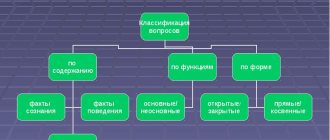At the moment, many people are experiencing various difficulties in the process of communication. During the period of interaction between several people, a communication barrier may arise. Such difficulties in communicating with people are naturally associated with the neuropsychic state of the individual. It is customary to distinguish between two types of difficulties in communication: subjective and objective experiences. Subjective ones do not always remain noticed by the interlocutor, but objective ones, on the contrary, appear during personal contact. In addition, there are also primary and secondary communication difficulties. Primary ones are associated primarily with the natural characteristics of a person, and secondary ones are the result of some kind of trauma or stress experienced. Defective communication can be considered defective, since sincerity, unpretentiousness, trust and ease in interaction between people cannot be established in interpersonal relationships. Difficulties in communication have arisen for a long time. But you can get rid of them if you adhere to several principles of interaction with your interlocutor.
Communication difficulties
At the moment, many people are experiencing various difficulties in the process of communication. When several people interact, a communication barrier may arise between them. In addition, there is a possibility of bilateral or multilateral complications in relations. This is usually associated with such personal qualities of the interlocutor as insincerity in communication, selfishness and sometimes even arrogance. Such difficulties in communicating with people are naturally associated with the neuropsychic state of the individual. There are differences that take into account the person’s stress level, the type of situation created, and other factors.
It is customary to distinguish between two types of difficulties in communication: subjective and objective experiences. Subjective ones do not always remain noticed by the interlocutor, but objective ones, on the contrary, appear during personal contact between people and are accompanied by a decrease in the degree of satisfaction from communication. Thus, people not only do not receive pleasure from the dialogue, but, on the contrary, are filled with negative emotions.
The problem of communication with subjective difficulties is characterized by the presence of such human qualities as shyness, embarrassment, uncertainty, and difficulty in making psychological contacts with people. Objective difficulties arise due to differences in the degree of communication literacy of the interlocutors. A specialist will be able to eliminate communication difficulties. A consultation with a psychologist in Moscow will help you cope with interaction problems when communicating with your interlocutor.
In addition, there are also primary and secondary communication difficulties. Primary ones are associated primarily with the natural characteristics of a person, and secondary ones are the result of some kind of trauma or stress experienced. Primary ones are characterized by such human qualities as anxiety, aggressiveness and many others, which are directly related to the temperament of the individual himself. Secondary communication problems can arise from poor previous practices in interacting with people. A consultation with a psychologist in Moscow will help treat this mental disorder.
Who has communication difficulties?
Communication is the mutual exchange of opinions, experiences, and emotions. Communication difficulties in adults are not uncommon. They occur in people who:
- We are used to judging. Condemnation for “wrong” actions is repellent. The interlocutor tells a personal story, and you respond with condemnation? This makes a person feel shame, guilt, anger or irritation.
- Often devalued. A friend says he feels bad. And you answer: “It’s nothing, don’t pay attention.” Such phrases devalue thoughts, actions, emotions.
- They don't think about other people's feelings. Imagine that your interlocutor is sharing his experiences... And you don’t pay attention to it, talk about yourself and your affairs. Once a person may not be offended. But if you don’t often show interest in your inner world, close interactions are unlikely to last long.
- They give advice instead of support. Most people get annoyed when they are given unsolicited advice. The “adviser” unconsciously belittles someone else’s experience. Remember your own emotions. I just want to talk. And instead of empathy, they advise you how to behave. I don’t want to share my secret anymore, do I?
- They don't want to open up. Sometimes you don't want to share your experiences. This is fine. But what if this is your usual behavior? It is difficult to communicate on equal terms with someone who is not ready to open up.
- They don't know how to listen. Imagine that you are either being interrupted or not being listened to attentively. What do you feel? Most likely, resentment, anger, grief.
- They don't understand body language. Not all information is conveyed through words. Sometimes important signals are transmitted through gestures, facial expressions, and body movements. Misunderstanding body language often leads to awkward situations.
- They don't know how to carry on a conversation. Lack of clarifying questions, monosyllabic answers, stock phrases – sound familiar? Few people want to communicate if there is no feedback.
- They provoke scandals. Do you like communicating with aggressive people? On the contrary, you want to protect yourself or run away. But don't continue the conversation.
Defective communication
This communication is characterized by the presence of some interference (communication defects). This relationship can be considered inferior, since there is no sincerity, unpretentiousness and ease in interaction between people. This communication problem contributes to the completion of interpersonal contacts between interlocutors. This disrupts the success of communication and reduces self-satisfaction with it.
Often the interlocutor can enter into communication while wearing a mask. Behind it, he tries to hide his character flaws (insecurity, etc.). The occurrence of interference in communication can be caused as a result of the emergence of a threat to lower self-esteem and self-esteem.
It is mainly character traits that create communication problems that can lead to conflict situations. A person’s emotional state plays a decisive role in establishing interpersonal relationships with an interlocutor. Many factors can complicate interaction during communication, which are primarily associated with increased emotionality. To improve relationships between interlocutors, it is necessary to rebuild communication, which is based on interpersonal cooperation with manifestations of effective communication. The ability to listen and hear is very important in communication.
In fact, communication difficulties arose a long time ago. But you can get rid of them if you adhere to several principles of interaction with your interlocutor. Listening to your interlocutor with interest, responding positively and adequately to his words, not interrupting him and not creating negative emotions in the dialogue will help improve communication. But if you can’t form successful communication on your own, then the help of a professional specialist will help create a favorable environment between the interlocutors. A consultation with a psychologist in Moscow will contribute to the formation of relationships based on effective communication. From such communication you will be able to get maximum pleasure and be 100 percent satisfied with the conversation, which will improve your mood and fill you with positive emotions from within.
Chapter 1. The concept of difficult communication and its causes
Modern psychology constantly turns to the study of man as a subject of diverse activities and his life in general. As a rule, regardless of the interpretation of the very concept of “subject of activity” and the levels of its consideration, the logic of studying this phenomenon is built in the direction of searching for those characteristics of human activity that lead to positive changes in himself and the world around him. The subject of effective, successful activity and the same communication is most often found in psychological research, while personality as a subject of destructive behavior, destruction of relationships, and interaction difficulties has not yet been sufficiently studied in domestic psychology, despite the enormous interest shown in this problem in related fields. branches of psychology.
Through the efforts of psychologists, psychotherapists, ethnographers, sociologists, philosophers, and cultural experts, another direction in the study of personality has been created - the psychology of difficult communication.
In Russian psychology, the problem of difficult communication is currently being discussed quite actively. Traditionally, it is considered in connection with issues of optimal communication. Difficult communication is determined, as a rule, on the basis of correlating existing communication with its optimal model. Ideas about the optimal model of communication (unimpeded communication) reflect the authors’ position regarding what communication is, what its structure, functions, goals and related processes, properties and states of the individual are. Most models of optimal communication resemble a list of requirements for the personality qualities of the subject of communication, for his skills and abilities. Failure to meet the specified parameters of optimal communication is considered an indicator of difficult communication. This approach is especially common in applied areas of psychology, for example, in the psychology of pedagogical communication or managerial interaction. It is in these areas of applied psychology that questions about the effectiveness of a teacher, leader, and manager as subjects of communication are most often discussed, and lists of properties, qualities, skills, and abilities necessary for optimal communication are compiled.
7
characteristic of modern psychology and is no different from the study of other aspects of communication.
From our point of view, difficult communication should be treated as a global, integral phenomenon. V.N. Kunitsyna emphasizes that the phenomenon of difficult communication is, first of all, a phenomenon represented in the consciousness and experience of partners. In Russian psychology, there has been a tradition of paying special attention to subjective factors, the causes of difficulties in communication, and the description of those conditions that are the result of poor communication or accompany friction and failures in communication. The first place is given to states of tension, dissatisfaction, anxiety, emotional distress, discomfort, etc.
A. A. Bodalev and G. A. Kovalev wrote about the subjective nature of psychological difficulties in communication, emphasizing that the consequence of these “subjective difficulties” is an objective picture of violations - failure to achieve a goal, dissatisfaction of a motive, failure to obtain the desired result, etc.
Thus, difficult communication must be considered on several levels:
as a socio-psychological phenomenon that manifests itself only in a situation of interaction, social communication;
as an objective phenomenon, presented in the discrepancy between the goal and the result, the chosen model of communication and the actual process;
as a subjective phenomenon that manifests itself in various kinds of human experiences, which may be based on unmet needs, motivational, cognitive, emotional dissonance, intrapersonal conflicts, etc.
There is no need to once again retell the content of works known in Russian psychology devoted to the problem of difficult communication. Research milestones are set out in the works of E. V. Tsukanova, V. N. Kunitsyna, A. A. Bodalev, G. A. Kovalev, V. A. Labunskaya, T. A. Arzhakaeva. Each of the named authors relies on the ideas of B.D. Parygin about the presence of a psychological barrier, which is understood as a stable attitude, psychological mood of the individual, processes, properties, states of a person, “which preserve the hidden emotional and intellectual potential of his activity.” This interpretation of the psychological barrier indicates an internal source of communication difficulties - stable personal formations, which under certain circumstances can lead to failures in communication.
There are studies that examine communicative, social-perceptual barriers that arise in public
8
Along with this method of interpreting communication as difficult, an assessment of the severity of difficulties is used depending on their impact on the results of communication. Based on this criterion, situations of difficult communication are determined: from mild friction, failures in communication that do not interfere with its continuation, to the level of conflict that leads to a complete break between partners. By assessing communication difficulties, classifications of communication difficulties can be created. For example, highlight situations of difficult communication that differ in the degree of understanding - misunderstanding by partners of each other, manifestations of sympathy - antipathy, acceptance - alienation, etc.
The problem of difficult communication is widely discussed in many articles and books on psychocorrection. They, as a rule, analyze the psychological, socio-psychological characteristics of the individual, leading to difficulties in communication.
Numerous data confirm the existence of a phenomenon of difficult communication that is specific in its psychological content. A number of generalizing works emphasize that difficult communication refers to a wide range of phenomena that can be reduced to unregulated, upset, disturbed, dysfunctional, uncomfortable, ineffective communication. The list of such characteristics of difficult communication could be continued, using synonyms or alternative definitions of optimal communication. And in this case, they would relate to definitions of experience, the state of a person experiencing difficulties in communication, or to some results of communication (unstable, ineffective, etc.). An analysis of the literature on this issue leads to the conclusion that the term “difficult communication” is used either as a broad concept that unites such phenomena as difficulties, difficulties, failures, complications, obstacles, obstacles, barriers, conflicts, or as a very narrow definition recording minor communication difficulties that are overcome by partners in the communication process and do not have far-reaching destructive consequences. As important characteristics of difficult communication, some works consider the severity of difficulties, their depth and intensity of impact on the results of communication. Conflict is studied as an extreme form of manifestation of communication difficulties. One of the first researchers of difficult communication, E.V. Tsukanova, noted that the variety of manifestations of difficult communication is explained by the fact that it is studied in different conceptual frameworks. Such a study of this phenomenon
9
NI. The most common point of view is that various difficulties in communication are a consequence of the developmental characteristics of the social-perceptual sphere of the individual (inadequate perceptions, understanding, assessment, self-esteem, etc.).
Supporting the emerging tradition, we will take the provisions of V. N. Kunitsa as the basis for the interpretation of difficult communication. From her point of view, “objective” difficulties are those that are detected in the conditions of direct communication, reduce its success and deprive the feeling of satisfaction from communication. “The so-called objective difficulties,” writes V.N. Kunitsyna, “that is, caused by objective and generally removable reasons, are difficulties of a communicative nature…. and sociable...” [92, p. 86]. Difficult communication objectively exists not only as a phenomenon of consciousness or experiences of partners. It is determined, as L.A. Petrovskaya emphasizes, by the peculiarities of the psychological nature of man and human relationships. She names the inharmonious development of various characteristics of the individual, her relationships and social context as a determinant of difficult communication. Communication itself, due to its socio-psychological nature, is a “difficult” activity. It actually and potentially contains elements that impede optimal levels of functioning. Features of expression and speech, the social-perceptual sphere of the individual, the system of his relationships, forms of address, the level of development of interaction skills and communication conditions turn any act of communication into a task, into a complex, multifaceted activity. Each facet of communication, according to I.P. Shkuratova, provides a new criterion for classifying difficulties and causes of difficult communication. Therefore, the list of both subjective and objective reasons that complicate the communication process cannot have clear boundaries, except for the framework established by the researcher. One of the broadest frameworks for studying communication difficulties is ethnocultural. Analysis of typical personality manifestations can be carried out at various levels.
The first of them is quasi-psychological
level of study of mental manifestations. At this level, ideas about ethnic or cultural stereotypes of the “independent” and “interdependent self” are analyzed or cultural ideas about the characteristics of behavior, character, system of relationships, etc. are studied.
On the second – interpsychological –
level of analysis, typical methods of behavior in situations of conflict, difficult communication, ethnic ideas, attitudes,
10
regulating role relationships between participants in joint activities. At the same time, it is possible to study ideas about the individual as a subject of difficult communication and their changes under the influence of the role status of partners.
The third – intrapsychological –
level of analysis of ethnic character, level of study of ethnic semantic attitudes. These formations appear as a result of the emergence of certain problem-conflict relationships, during which stereotypes and ideas that exist in ethnic culture are transformed into personal meanings. At this level of analysis, the results of studying cognitive-emotional formations transformed into personal meanings of communication partners can be considered.
In many ways, the listed communication factors are the result of the “us” and “them” mechanism. B. D. Parygin believes that “the origins of psychological barriers lie in the very fact of the existence of a community and the individual’s belonging to it” [141, p. 7]. The isolation of individuals within the community “we” is explained by the mechanism of opposition to another community – “they”. The parameters by which such a contrast is made are different, but “the main thing is that “we” react to certain situations, certain stimuli in this way (which unites us) and they react to the same thing in a different way.” Dissimilarity limits contacts, leads to hostility and clashes, in short, to difficult communication. In accordance with these fundamental mechanisms of the functioning of communities, B. D. Parygin identified the following determinants: 1) the strength of collective norms, values, actions; 2) a system of value orientations of the individual [140, p. 52]. Recent works emphasize that an ethnos contributes to the formation among its members of a common vision of the world, common ideas about values, and the meaning of life. However, an ethnos imposes restrictions on people’s behavior, narrows the range of permissible and desirable human reactions to a particular life situation, and the emerging ideas about the norms of communication become more and more autonomous in relation to their bearers and, regardless of them, begin to regulate interaction both within the ethnos and beyond. As is known, ethnic stereotypes are based on a system of ethnic ideas - stable, generalized, emotionally rich images that act as regulators of communication.
Thus, the emergence of situations of difficult communication and difficulties in communication is due to the fact of the formation of the human community, the peculiarities of personality development in a certain social environment, socio-psychological
11
the nature of communication, mechanisms of reflection and interaction. It is they who provoke disruptions in the socio-perceptual, interactional, and communicative systems of communication, leading to friction and the emergence of mental tension of varying intensity between people.
So, in the narrow sense of the word, difficult communication is minor friction and failures in the sphere of interpersonal communication. Such communication is characterized by: safety, continuity of contacts between partners, a certain degree of awareness of the difficulties experienced; searching for reasons leading to communication complications; attempts to independently overcome social-perceptual, interactional, and communicative difficulties. In the broad sense of the word, difficult communication is all types and forms of communication (from interpersonal to intergroup), leading to destructive changes in the behavior of partners and communities, to continuous contacts between them, up to refusal of communication, to a decrease in the level of awareness of the causes of difficulties in communication, to a decrease, and in some cases to the disappearance, of attempts to independently overcome difficulties that have arisen, to the formation of an anxious attitude towards any communication situation.
The definition of “difficult communication” includes both the process and the result of communication, which has both a subjective and objective nature. But, whatever the result (subjective or objective), it is presented to the participants of communication through the intensity, sign, direction, modality of their emotional experiences, through the degree of cognitive-affective tension, a feeling of comfort - discomfort; experienced by them in the process of communication. The number of unpleasant” ways of communication that frustrate a partner, creating barriers, obstacles in achieving goals and satisfying basic social needs, or, conversely, the amount of means and methods of communication that help achieve goals and satisfy needs are objective-subjective indicators of communication occurring within scale “difficult – undifficult communication”.
In foreign psychology, the concept of “difficult communication” is designated by the term “miscommunication”. In a broad sense, difficult communication refers to the appearance of any kind of problems in interaction and communication, and in a narrow sense, difficult communication represents facts of misunderstanding that arise in communication. Similar to the concept of “miscommunication” are the concepts of “communication breakdown” - a breakdown in communication, “pseudo-communication” - pseudo-communication, “communication failure” - unsuccessful communication, “deficiency communication” - deficient
12
communication. The closest in meaning to the definition of “difficult communication” adopted in Russian psychology is the concept of deficient communication, which describes situations when communication partners are dissatisfied with each other, cannot achieve their goals, establish an open dialogue, when they are faced with unforeseen obstacles, misunderstandings develop, conflicts arise, etc.
The paired concepts “difficult – undifficult communication” are not synonymous with the concepts “successful – unsuccessful”, “effective – ineffective”, “optimal – non-optimal communication”. These assessments of communication reflect objective indicators of achieving its result, but do not take into account the range of experiences that arise in the process of communication and individual assessments of each partner.
In the psychology of difficult communication, as in the psychology of effective, optimal communication, there is a combination of causes
occurrence of difficulties,
results
and
characteristics of communication participants.
Personality characteristics can be the cause of difficulties in communication or the result of communication; they can be considered as external or internal, subjective or objective factors. A classification of the causes of difficult communication, taking into account the inextricable connection between communication and personality, is presented in a number of works [20, 39, 92, 145, 190].
An analysis of research conducted in the field of psychology of difficult communication and the psychology of effective interaction also indicates that the main areas of consideration of this phenomenon have become such types of communication as interpersonal, role-playing, manipulative, monologue, studied in the context of business, pedagogical, ethnic communication , as well as in conditions of socio-psychological training.
Thus, difficulties arising in communication (reasons for difficult communication) can be classified as follows:
- objective, generated by real interaction, and subjective, related to various aspects of the functioning of an individual or group (dynamic processes in a group and between groups, cultural and psychological characteristics of its members);
- primary (natural living conditions of the group, the history of its formation and relations with other groups) and secondary, generated by various psychogenic and sociogenic influences;
- conscious, actually present in a communication situation and unconscious, not subjectively experienced by the individual and the group.
13
sing; represented in the consciousness of a person, but really non-existent;
- situational or stable;
- intercultural and culture-specific;
- general age and gender (masculinity - femininity), gender;
- individual psychological, personal, socio-psychological;
- cognitive-emotional (ideas, opinions, stereotypes, attitudes, moods, prevailing emotional states, value orientations, etc.), motivational and instrumental (communication skills, etiquette rules, norms, rituals, methods of treatment accepted in the group, etc. .);
- components of the communication structure (social-perceptual, communicative, interactive);
10) verbal and non-verbal.











